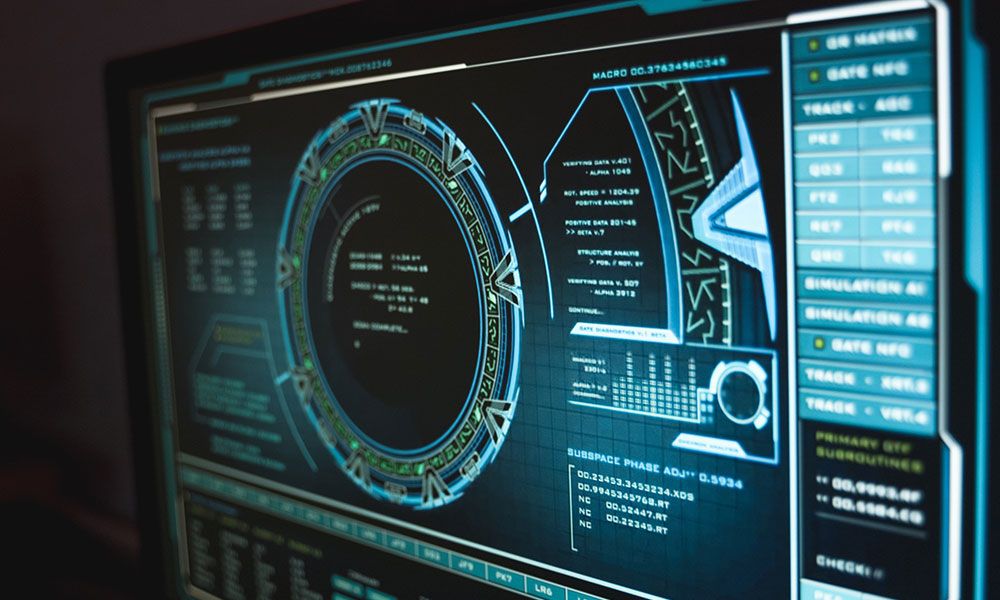How Cybersecurity is Changing Technology Today

Tech is expanding, and so are the number of threats and vulnerabilities. The number of potential risks is rising, creating a security gap between the expectations of users and technology suppliers. In short, cybersecurity is changing how things are done today more than ever before.
Cybersecurity is a term that many of us hear about daily in our lives. In this article, we want to dive deeper into how cyber security has altered today's technological world and how it will continue moving forward.
Data Breaches in the News
Data breaches result from vulnerabilities or gaps in a company's security posture, which cybercriminals exploit to gain access.
As a result, the financial risk of data loss can be devastating. According to the 2021 Internet Crime Report of the Federal Bureau of Investigation, organizations lost $6.9 billion in 2021 due to cybercrime worldwide. In most cases, these losses are caused by breaches where large amounts of personal information are stolen, including social security numbers or credit card details.
Once cybercriminals gain access to your personal information, they may attempt to use it for their gain. For example, they can use your personal information to make fraudulent purchases, drain your bank account, or otherwise take advantage of you to commit some of these frauds:
- Get and use new credit cards and the ones you already have.
- Deposit or withdraw money from your bank or investment accounts.
- File for a tax refund under your name.
- Use your health insurance to get medical treatment.
- Take advantage of government benefits.
- Use your credit card rewards to save money or get free flights.
In addition, criminals who access large amounts of stolen information often sell or trade it on the dark web, according to Experian. For example, Social Security numbers might go for $1 each; a credit card number could sell for up to $110; US passports could sell for up to $2,000 - although buyers may try discounting them based on their quality rating or other factors.
Past And Recent Data Breaches
The following is a selection of recent high-profile cybersecurity breaches and web attacks that have demonstrated how technology has advanced to today's level of impact on you, your business, and society as a whole.
Capital One
In July 2019, Capital One reported that an unauthorized user broke through its security measures and accessed 140,000 U.S.-based Social Security numbers, 80,000 linked bank account numbers from the United States and Canada, and approximately 1 million Canadian Social Insurance Numbers.
The breach affected over 100 million United States and Canadian credit card users. As a result, capital One was the victim of one of the most significant data breaches in the financial services industry.
Marriott International
In November 2018, hotel chain Marriott International announced that hackers had accessed its Starwood guest reservation database. The breach exposed the personally identifiable information of about 383 million guests, including names, phone numbers, email addresses, and passport numbers.
In addition to all this, last month, The Marriott Hotel group confirmed that it suffered another data breach, with hackers stealing 20 gigabytes of sensitive information, including credit card numbers.
Marriott said it had identified the incident and was investigating before a threat actor targeted Marriott in an attempt to extort money from it, which Marriott did not agree to pay.
A group claiming responsibility for the attack says it has obtained credit card information and confidential data about employees and guests.
Colonial Pipeline
In May 2021, Colonial Pipeline—a significant oil pipeline operator from Houston, Texas—was hit by a cyberattack that compromised its automated operational technologies and systems to manage oil flow.
This incident affected the East Coast, leading to shortages in many states. It took several months to fully restore—even though the company paid ransom to regain access to critical data, which was stolen when hackers infected their systems.
In response to the hack, Colonial paid a ransom of $4.4 million (paid in bitcoins) shortly after being breached by DarkSide Group. This Russia-linked cybercrime group conducts business online using ransomware and other forms of extortion involving cryptocurrencies like Bitcoin.
Cybersecurity In The Next Four Years: What You Need To Know
According to Cybersecurity Ventures, cybercrime costs will increase by 15% annually over the next five years, resulting in $10.5 trillion in 2025 (up from $3 trillion in 2015).
This transfer of wealth is more significant than any in history. It risks innovation and investment by removing incentives for individuals to create their businesses or work within larger companies. It will be larger than the $306 billion in damages caused by natural disasters in 2017—and more lucrative than the global drug trade, which represents a $32 billion market, according the United Nations
These are the aspects most enterprises will need to consider through the end of 2026, according to the research firm Gartner:
- Over the next five years, government regulations requiring companies to provide consumers with privacy rights will cover more than five billion people—over 70% of global GDP. Consumer privacy rights have grown exponentially over the last year, with 3 billion individuals accessing such rights across 50 countries.
- By 2025, 60% of organizations will have adopted a zero-trust model. However, more than half will fail to reap the benefits it offers—primarily due to its costs and complexity in deployment.
- Also, by 2025, 30% of nation-states will pass legislation governing ransomware payments and negotiations with cybercriminals—up from less than 1% in 2021.
- It is expected that 70% of CEOs in 2025 will mandate a culture of organizational resilience to cope with coinciding threats such as terrorism, cyberattacks, data breaches, civil unrest, and political instability.
- 50% of C-level executives' contracts will have risk-related performance requirements by 2026. As predicted, cybersecurity will be a top concern for businesses in the next four years. For high-level executives, incentive-based contracts are expected to reward them for responding to cyber threats. The goal of this is to increase C-level executives' accountability for cybersecurity.
Cybersecurity and Innovation: Connecting The Dots
Increasing the detection of viruses, reducing false positives, and protecting against attacks have all become part of cybersecurity's endless efforts to minimize risk.
People are increasingly using the internet to connect and share personal information and make cyber threats—which can range from identity theft to sophisticated military operations. In addition, our world's systems are becoming more automated and connected to the internet, putting us at risk for cyberattacks on a massive scale.
With social media making more people's data available and accessible to strangers, everyone shares more information that cybercriminals can exploit. This is due to the vast amount of personal data online that makes it easier for phishing attacks to succeed.
Another critical factor is that there are entire generations of people today who have grown up with the internet and understand its complexity better than older generations. As a result, cybersecurity is perceived—and could be acted upon differently than it might be if its definition were rooted in the experiences of older generations, as Millenials, Gen Z, and Gen Alpha were born and raised as digital natives. They are responsible for the progress of the latest trends in cybersecurity over the next few years.
At the corporate level, forced by the massive breaches at companies like Linkedin or Marriott International, many corporations have begun seeking for options and have implemented the following systems to improve their cybersecurity:
Solution providers for continuous monitoring
An effective cyber security monitoring strategy identifies all data and vulnerabilities within a network or system to support compliance, security, and business growth.
Monitoring your network for intrusions is critical to securing it. An intrusion detection system (IDS) does just that—it scans a network looking for suspicious activity, such as policy violations or malicious software.
Reports and data collected from a security information and event management system may be used to identify suspicious activity. An IDS can be classified into the following types:
- A network IDS monitors the traffic coming into a computer network.
- Host-based IDS are designed to monitor critical files within the operating system.
- Perimeter IDS systems detect intruders by identifying changes in patterns.
- Virtual machine-based intrusion detection systems (VMIDS) use a combination of network, host-based, and perimeter IDS systems to monitor remote computer resources.
Services in cybersecurity management
A managed cybersecurity service is an outsourced IT department that assists with all network security processes. Some key features include:
- Assessments and audits—These are efforts to assess the status of an organization's security measures, which gives insight into the network vulnerabilities that exist.
- Companies could benefit from IT security staffing for professional advice, insight, and assistance to maintain a solid cyber strategy.
Cybersecurity is a concept that has evolved over the years. It was not always present, but when it came into existence, it changed how we think about security and privacy. In addition, the evolution of cybersecurity has increased awareness and overall preparedness for threats.
Cybersecurity awareness is crucial today because with this awareness comes preparation for potential attacks and an understanding of how to combat these attacks.
Using AI and machine learning to enhance cybersecurity
Today, the growing importance of AI and machine learning increasingly shapes cybersecurity in all sectors of life. The integration of these technologies has given rise to new challenges for cyber security professionals, who must now look beyond traditional security approaches to protect their customers' data.
AI can help improve cyber security in many ways – for example, by making it easier to detect anomalies in your network traffic or by allowing you to predict potential threats before they occur (with improved threat intelligence). This could save enterprises millions of dollars in damages and lost revenue due to data breaches. But AI also brings risks: attackers could use machine learning algorithms against defenders by exploiting vulnerabilities in their networks or software.
From the days of firewalls, anti-virus software, and patching operating systems to today’s AI-powered solutions, the business of cybersecurity has become more complex and expensive.
ED&F Man Holdings' usage of the Cognito system
A security incident occurred several years ago at commodities trader ED&F Man Holdings. A cybersecurity assessment indicated the company needed to improve its processes and tools.
The company turned to Cognito, Vectra’s AI-based threat detection and response platform. Cognito collects and stores network metadata—information about how a computer communicates with other machines on the internet—and then enriches it with unique security insights before using machine learning techniques to detect attacks in real-time based on this information.
Cognito identified several man-in-the-middle attacks, as well as a cryptocurrency mining scheme that was running in Asia. The company also uncovered hidden malware—which had been operating for several years.
The State of Cybersecurity and Emerging Technologies
The cybersecurity landscape has always been challenging as new technologies and methods are developed, resulting in organizations identifying vulnerabilities around authentication, networking, and trust-based security. Furthermore, companies are considering how quantum computing and artificial intelligence (AI) weaponization may affect their operations.
Let's look at the connection between cybersecurity and some of today's most relevant emerging technologies.
Quantum Computing in Cybersecurity
The quantum revolution has arrived. Although the profound impact of large-scale fault-tolerant quantum computers—which promise to speed up certain types of computations by many orders of magnitude over today's machines—will be felt a decade from now rather than sooner. Still, near-term quantum computers will provide tremendous benefits.
However, quantum computing faces many security challenges due to essential factors such as:
- Random number generation is crucial to cryptography, which plays a central role. Unfortunately, many conventional random number generators rely on algorithms known as pseudo-random number generators and therefore are not truly random, which opens them up to possible compromise.
If computers were not programmed to provide some randomness in their responses, all cryptographic operations would be predictable and thus insecure. When computer algorithms are fed with the same input, they should always give the same output; this is predictable behaviour—and, therefore, a bad source of random numbers. As a result, decryption of the information may allow attackers to steal vital information. - Quantum computing is such a powerful technology that some believe it could be used to compromise public-key cryptography, including the RSA algorithm—an idea with potentially staggering implications for eCommerce. The threat to public-key cryptography has given rise to invulnerable algorithms even if they fall into the hands of a quantum computer.
We are seeing increasing investment in the fundamental research necessary to scale qubit count, correct errors, and develop algorithms to face security threats. While quantum computing may render some existing encryption protocols obsolete, it promises to enable a substantially enhanced level of communication security and privacy.
A long-term perspective on quantum computing and technology and engaging severely today will help your company prepare for tomorrow's quantum revolution.
Cybersecurity and the Metaverse
The metaverse offers excellent growth potential but poses serious threats to privacy and security. Because everything is built virtually in the metaverse—including computer programs that cybercriminals can manipulate—there are plenty of ways to hack into other people's data and misuse it for personal gain.
Among the risks that metaverse users face, phishing emails, data hacking, and malware attacks are similar to those faced by internet users. However, the unique architecture on which the metaverse is built brings additional challenges to anyone who tries to navigate it. For example, digital currencies and non-fungible tokens (NFTs) are used in the metaverse for various purposes, but hackers may find these items exciting simply because they can be manipulated.
Like the internet, a combination of software and hardware security solutions will help propel the metaverse to its fullest potential. The assets and equipment in the metaverse must be able to detect threats, offer protection against primary risks, and provide users with special devices—such as smart glasses or VR headsets—to enjoy their immersive virtual world.
Although these devices are critical to the functioning of the metaverse, their lack of security mechanisms makes them vulnerable targets for hackers. Therefore, equipment must have high-grade safety and security features to prevent unauthorized leaks.
In addition, one of the most critical challenges for policymakers and regulators is to address intellectual property rights in the virtual space, which opens the way to the theft of digital assets since there is still no legislation to protect the rights of the original owners.
If we end up in a closed metaverse, owned and controlled by Big Tech, the security threats will likely be much worse than when we create an open metaverse built on Web3 infrastructure.
However, hackers can steal sensitive information about users' accounts and business transactions by exploiting weak links such as wearable equipment and network connectivity and by hacking hot wallets to steal NFTs or cryptocurrencies. Therefore, to access the digitally connected world of the metaverse, all stakeholders should provide safe equipment while encouraging users to be careful when stepping into the metaverse.
How Does IoT Affect Cybersecurity?
IoT is one area where privacy is a serious concern, and it is a concern across all applications, devices, and systems that share information. There are certain conditions beyond the control of users, even when they take precautions to ensure their information is secure. Hackers can now design attacks of unprecedented sophistication, combining data from various private and public sources, including cars, smartphones, home automation systems, and refrigerators.
According to a report from Cisco, the number of connected devices to the internet will be three times greater than the worldwide population by 2023. A report by Statista estimates that 75 billion devices will be connected by 2025. Furthermore, with the rapid evolution of technology, hackers and their enemies can attack more things related to the internet.
In fact, according to ThreatPost, nearly 98% of IoT traffic is unencrypted, leaving users' private information vulnerable. Undeniably, our lack of knowledge of interconnected technology defeats our ability to secure it, and we must educate ourselves to change this situation.
As the industry innovates and builds devices that integrate with the internet, it needs to learn from its mistakes. The latest updates, fixes, and patches, as well as hardening the systems, are some of the best security practices that can be utilized. However, the future of security will be managed automatically by the system rather than the users, so innovators must rethink their approach to designing secure technologies.
The IoT device industry only implemented encryption in 24% of IoT devices in 2021, leaving 76% of devices entirely unencrypted. Regarding attack frequency, CCTVs and digital video recorders were the most commonly targeted devices.
Thanks to this widespread network of the IoT, the cyber security landscape is already adjusting to its new demands. The bad news is that we are far from a utopia where IoT devices manage security automatically and provide safe infrastructure for their users.
Within a few years, we may experience a whole new class of cyber security concerns, just as we have experienced in the past. However, the smart IoT network's current problems will hopefully be solved by then with some of the actions listed below.
Cybersecurity is Key to Business Success
To protect your company against cybercrime, you need a robust cybersecurity strategy that includes multiple layers of protection to prevent those that aim to access, change, or destroy your data, extort your employees or business, or disrupt your business operations daily.
If data is destroyed, the company must spend hours restoring and fixing it and assuring investors that it won't happen again. In addition to the millions of dollars lost in monetary terms, what affects organizations is their notoriety and prominence in their industry. These attacks can damage an organization's reputation, investors may withdraw financial support if cybercriminals repeatedly attack it, and customers might walk away.
An attack can occur in any industry that relies on the internet. The most vulnerable sectors are healthcare institutions, higher education facilities, and government entities.
Regardless of your industry, here are some recommendations to protect your company or organization from cyber attacks.
- A cybersecurity training program for your employees can help prevent cyberattacks. In addition, many promote cybersecurity awareness, such as educating people on how to avoid malware and not clicking on unknown emails to promote safety in the workplace.
- Cybersecurity insurance is a wise investment. This insurance covers your organization in case of a data breach involving sensitive customer information, such as Social Security numbers, credit card numbers, account numbers, driver's license numbers, and health records.
- Embrace technology to fight cyberattacks. Approximately 48% of senior executives said their budgets for artificial intelligence in cybersecurity would increase by 29% in Fiscal Year (FY) 2020, according to Capgemini's 2019 report Reinventing Cybersecurity with Artificial Intelligence. In addition, approximately 64% of respondents said AI reduces the cost of detecting and responding to breaches and detection time by up to 12%.
Security systems should incorporate AI to combat cyber attacks. Businesses can enhance their security threat hunting process by feeding AI high volumes of application data, which AI can comprehensively analyze to detect threats and implement the most effective combat strategies.
Take the time to assess your business or organization's vulnerability to AI attacks. A cybersecurity expert can help you develop strategies to mitigate the potential impact of these attacks.
Final Thoughts
The internet was hailed as the great equalizer enabling individuals and small businesses to compete against large corporations and institutions. However, individual cyber crimes are increasingly perpetrated by criminal enterprises, not lone hackers, and even by state actors. That's why anyone operating a critical infrastructure business needs a clear cybersecurity plan that spans technology, operations, human resources, and strategic planning.
The tech world isn't slowing down, and neither is the future of cybersecurity. With the ongoing changes that technology is experiencing, we will be able to see the future more clearer than ever. However, regardless of whether or not mainstream organizations choose to use it, as long as there is technology and crime, security must evolve with us.





